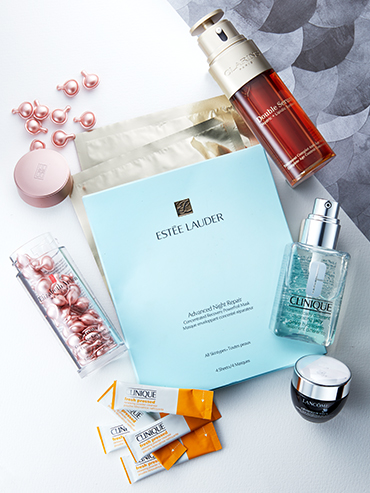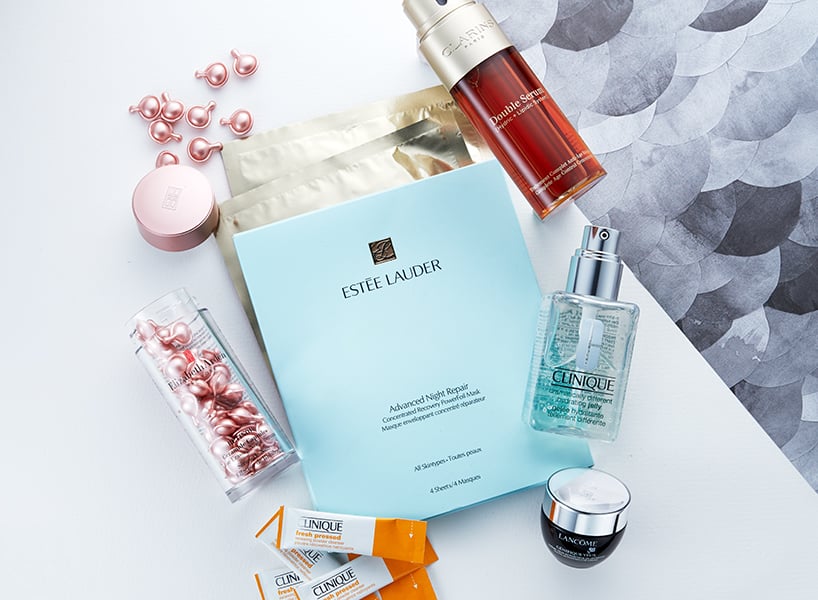The 5 Buzziest Skincare Ingredients of 2018
We’re adopting every one of them into our fall routines, immediately

In partnership with Hudson’s Bay

The year may not be over yet, but now that the first morning frost has landed on our car windows, we’re already looking back at the year’s top trends in skincare. And why not? Skincare is huuuge right now. Take for example, the on-going no makeup-makeup trend that, let’s face it, only really works if you’ve seriously levelled up your skincare routine. Or the fact that skincare sales (led by moisturizers) are far surpassing cosmetics sales in Canada, according to leading analyst NPD Group.
And, finally, who couldn’t notice how thirsty everyone has become to find the next big ingredient in skincare? (Bird pooh facials, blood moisturizers—we’re looking at you.) But guess what? The biggest trend in skincare right now is a return to tried-and-true ingredients. They may not be new, but hero ingredients like vitamin C and retinol are currently experiencing a massive resurgence—be it with better delivery systems or textures that are so luxurious they’re life-affirming. Here, we’ve rounded up the top five buzziest ingredients of the year that we’re adopting into our own fall skincare routines, STAT.
Vitamin C
If dark splotches, acne scarring or simply overall dullness from staying up too late have literally sucked the life out of your skin, vitamin C is your new BFF. Also known as ascorbic acid or L-ascorbic acid, the superstar ingredient helps nudge along sluggish cell turnover in addition to prodding collagen and elastin production. The potent antioxidant can even help reverse cell damage from free radicals you may have encountered while biking through the smog last summer. Good news: the très active ingredient, known to destabilize when exposed to light and air, can lately be found in powder pouches you mix up at your sink for max potency.
Find it in: Clinique Fresh Pressed Renewing Cleansing Powder With Pure Vitamin C, $40/28 pack
Turmeric
Marco Polo may have rubbed turmeric on his wounds when he travelled with it from India to China many moons ago, but curcuma longa—as it’s called in botanical-speak—has been used for thousands of years in Ayurvedic medicine to promote a glowing visage. In more recent years, cosmetic developers have tapped into the antioxidant’s antiseptic and purifying properties, in addition to its storied healing wizardry. Said to aid in “cellular listening,” scientists are still discovering just how effective the golden powder really is when it comes to stimulating cells far below the surface. Try it in a serum for a deep-down kick.
Find it in: Clarins Double Serum, $89-$120
Probiotics
You may have heard the words “microbiome” and “skin” used in the same sentence over the past few years, ever since researchers uncovered the complexity of each of our skin surface’s unique “cities” of good and bad microflora, and the effect it has on its condition. For just as probiotic supplements exist to chill angry bellies, topical probiotic ingredients such as lactobacillus and bifodobacteria are believed to balance the bad flora that could be causing you acne and redness. They also help strengthen and defend your skin’s barrier as a whole, perfect in an eye cream situation for the rude winter ahead.
Find it in: Lancôme Advanced Génifique Yeux Youth Activating Eye Cream, $83
Hyaluronic Acid
Doesn’t matter your age, dehydration eventually gets to us all. And for those straight-off-the-tarmac and furnace-cranked moments, there’s hyaluronic acid. The mother of all skin plumpers, this naturally occurring skin substance has the miraculous ability to attract moisture from the air, and hold 1,000 times its weight in water. Hence why HA actually defies the “trend” moniker, though few can deny how prevalent it is in skincare these days. Safe for all skin types, from acne-prone to sensitive, hyaluronic acid need not come in the form of a heavy night cream to pack a moisture punch—a boon for anyone who knows what it feels like to experience a profusion of oiliness and a lack of hydration at once.
Find it in: Clinique Dramatically Different Hydrating Jelly, $36; Estée Lauder Advanced Night Repair Sheet Mask, $25
Retinol
Ask a dermatologist what their desert island skincare product is and they will undoubtedly name retinol (along with SPF, because its use makes skin more UV-sensitive). A derivative of vitamin A, this gold standard ingredient has forty years of research and results behind it. While retinol isn’t as strong as its by-prescription cousin, retinoids, it still comes in like a boss, wiping out old, dull skin cells and bringing in a fresh team. Retinol also rules in collagen production, improving the look of fine lines, scars, discolouration—even acne. Tip-toe in, using once a week in the evening, then working your way up to whatever frequency your skin can handle, to avoid peeling from overuse. And remember, retinol loses strength with light and oxygen, so store in a dark place or look for individually dosed capsules that protect ingredient efficacy.
Find it in: Elizabeth Arden Ceramide Retinol Capsules Line Erasing Night Serum, $106








